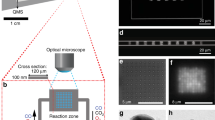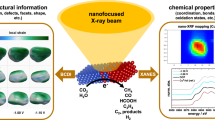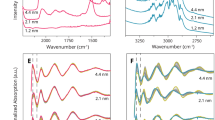Abstract
Nitrogen oxide (NOx) emissions are a major source of pollution, demanding ever-improving performance from catalytic after-treatment systems. However, catalyst development is often hindered by limited understanding of the catalyst at work, exacerbated by widespread use of model catalysts rather than technical catalysts, and by global rather than spatially resolved characterization tools. Here we combine operando X-ray absorption spectroscopy with microtomography to perform three-dimensional chemical imaging of the chemical state of copper species in a Cu-SSZ-13 washcoated monolith catalyst during NOx reduction. Gradients in copper oxidation state and coordination environment, resulting from an interplay of NOx reduction with adsorption–desorption of NH3 and mass transport phenomena, were revealed at micrometre spatial resolution while simultaneously determining catalytic performance. Crucially, direct three-dimensional visualization of complex reactions on non-model catalysts is feasible only by the use of operando X-ray spectrotomography, which can improve our understanding of structure–activity relationships, including the observation of mass and heat transport effects.

This is a preview of subscription content, access via your institution
Access options
Access Nature and 54 other Nature Portfolio journals
Get Nature+, our best-value online-access subscription
$29.99 / 30 days
cancel any time
Subscribe to this journal
Receive 12 digital issues and online access to articles
$119.00 per year
only $9.92 per issue
Buy this article
- Purchase on Springer Link
- Instant access to full article PDF
Prices may be subject to local taxes which are calculated during checkout



Similar content being viewed by others
Data availability
Raw data were generated at the Swiss Light Source of the Paul Scherrer Institut (Switzerland). The collected and cleaned imaging data acquired before tomographic reconstruction that support the findings of this study are stored in KITopen, the central repository of the Karlsruhe Institute of Technology, and are freely available with the following DOIs: 200 °C dataset, https://doi.org/10.5445/IR/1000122874; 300 °C dataset, https://doi.org/10.5445/IR/1000122890; 350 °C dataset, https://doi.org/10.5445/IR/1000122892; 400 °C dataset, https://doi.org/10.5445/IR/1000122893; NH3 reference dataset, https://doi.org/10.5445/IR/1000122894; NO reference dataset, https://doi.org/10.5445/IR/1000122895. Additional data, including reconstructed and treated spectrotomography datasets, are available from the authors upon reasonable request. Source Data for Figs. 1–3 are provided with the paper.
References
Beale, A. M., Gao, F., Lezcano-Gonzalez, I., Peden, C. H. F. & Szanyi, J. Recent advances in automotive catalysis for NOx emission control by small-pore microporous materials. Chem. Soc. Rev. 44, 7371–7405 (2015).
Borfecchia, E. et al. Cu-CHA—a model system for applied selective redox catalysis. Chem. Soc. Rev. 47, 8097–8133 (2018).
Lomachenko, K. A. et al. The Cu-CHA deNOx catalyst in action: temperature-dependent NH3-assisted selective catalytic reduction monitored by operando XAS and XES. J. Am. Chem. Soc. 138, 12025–12028 (2016).
Janssens, T. V. W. et al. A consistent reaction scheme for the selective catalytic reduction of nitrogen oxides with ammonia. ACS Catal. 5, 2832–2845 (2015).
Bates, S. A. et al. Identification of the active Cu site in standard selective catalytic reduction with ammonia on Cu-SSZ-13. J. Catal. 312, 87–97 (2014).
Günter, T. et al. Structural snapshots of the SCR reaction mechanism on Cu-SSZ-13. Chem. Commun. 51, 9227–9230 (2015).
Günter, T. et al. The SCR of NOx with NH3 examined by novel X-ray emission and X-ray absorption methods. Top. Catal. 59, 866–874 (2016).
Paolucci, C. et al. Dynamic multinuclear sites formed by mobilized copper ions in NOx selective catalytic reduction. Science 357, 898–903 (2017).
Fahami, A. R. et al. The dynamic nature of Cu sites in Cu-SSZ-13 and the origin of the seagull NOx conversion profile during NH3-SCR. React. Chem. Eng. 4, 1000–1018 (2019).
Kerkeni, B. et al. Copper coordination to water and ammonia in CuII-exchanged SSZ-13: atomistic insights from DFT calculations and in situ XAS experiments. J. Phys. Chem. C 122, 16741–16755 (2018).
Auvray, X. et al. Local ammonia storage and ammonia inhibition in a monolithic copper-beta zeolite SCR catalyst. Appl. Catal. B 126, 144–152 (2012).
Marberger, A. et al. Time-resolved copper speciation during selective catalytic reduction of NO on Cu-SSZ-13. Nat. Catal. 1, 221–227 (2018).
Greenaway, A. G. et al. Detection of key transient Cu intermediates in SSZ-13 during NH3-SCR deNOx by modulation excitation IR spectroscopy. Chem. Sci. 11, 447–455 (2020).
Clark, A. H. et al. Selective catalytic reduction of NO with NH3 on Cu‐SSZ‐13: deciphering the low- and high‐temperature rate‐limiting steps by transient XAS experiments. ChemCatChem 12, 1429–1435 (2020).
Grunwaldt, J.-D., Wagner, J. B. & Dunin-Borkowski, R. E. Imaging catalysts at work: a hierarchical approach from the macro- to the meso- and nano-scale. ChemCatChem 5, 62–80 (2013).
Gänzler, A. M. et al. Unravelling the different reaction pathways for low temperature CO oxidation on Pt/CeO2 and Pt/Al2O3 by spatially resolved structure–activity correlations. J. Phys. Chem. Lett. 10, 7698–7705 (2019).
Andrews, J. C. & Weckhuysen, B. M. Hard X‐ray spectroscopic nano‐imaging of hierarchical functional materials at work. ChemPhysChem 14, 3655–3666 (2013).
Goguet, A., Stewart, C., Touitou, J. & Morgan, K. in Spatially Resolved Operando Measurements in Heterogeneous Catalytic Reactors Vol. 50 (eds Dixon, A. G. & Deutschmann, O.) 131–160 (Elsevier, 2017).
Dong, Y., Korup, O., Gerdts, J., Roldán Cuenya, B. & Horn, R. Microtomography-based CFD modeling of a fixed-bed reactor with an open-cell foam monolith and experimental verification by reactor profile measurements. Chem. Eng. J. 353, 176–188 (2018).
Jurtz, N., Kraume, M. & Wehinger, G. D. Advances in fixed-bed reactor modeling using particle-resolved computational fluid dynamics (CFD). Rev. Chem. Eng. 35, 139–190 (2019).
Buurmans, I. L. C. & Weckhuysen, B. M. Heterogeneities of individual catalyst particles in space and time as monitored by spectroscopy. Nat. Chem. 4, 873–886 (2012).
Urakawa, A. & Baiker, A. Space-resolved profiling relevant in heterogeneous catalysis. Top. Catal. 52, 1312–1322 (2009).
Beale, A. M., Jacques, S. D. M. & Weckhuysen, B. M. Chemical imaging of catalytic solids with synchrotron radiation. Chem. Soc. Rev. 39, 4656–4672 (2010).
Sanchez, D. F. et al. 2D/3D microanalysis by energy dispersive X-ray absorption spectroscopy tomography. Sci. Rep. 7, 16453 (2017).
Ihli, J. et al. A three-dimensional view of structural changes caused by deactivation of fluid catalytic cracking catalysts. Nat. Commun. 8, 809 (2017).
Sheppard, T. L. et al. In situ multimodal 3D chemical imaging of a hierarchically structured Core@Shell catalyst. J. Am. Chem. Soc. 139, 7855–7863 (2017).
Weker, J. N., Huang, X. & Toney, M. F. In situ X-ray-based imaging of nano materials. Curr. Op. Chem. Eng. 12, 14–21 (2016).
Price, S. W. T. et al. Chemical imaging of single catalyst particles with scanning μ-XANES-CT and μ-XRF-CT. Phys. Chem. Chem. Phys. 17, 521–529 (2015).
Becher, J. et al. Mapping the pore architecture of structured catalyst monoliths from nanometer to centimeter scale with electron and X-ray tomographies. J. Phys. Chem. C 123, 25197–25208 (2019).
Hofmann, G. et al. Aging of a Pt/Al2O3 exhaust gas catalyst monitored by quasi in situ X-ray micro computed tomography. RSC Adv. 5, 6893–6905 (2015).
Meirer, F. et al. Mapping metals incorporation of a whole single catalyst particle using element specific X-ray nanotomography. J. Am. Chem. Soc. 137, 102–105 (2015).
Bossers, K. W. et al. Correlated X-ray ptychography and fluorescence nano-tomography on the fragmentation behavior of an individual catalyst particle during the early stages of olefin polymerization. J. Am. Chem. Soc. 142, 3691–3695 (2020).
Price, S. W. T. et al. Chemical imaging of Fischer–Tropsch catalysts under operating conditions. Sci. Adv. 3, e1602838 (2017).
Senecal, P. et al. Real-time scattering-contrast imaging of a supported cobalt-based catalyst body during activation and Fischer–Tropsch synthesis revealing spatial dependence of particle size and phase on catalytic properties. ACS Catal. 7, 2284–2293 (2017).
Cats, K. et al. Active phase distribution changes within a catalyst particle during Fischer–Tropsch synthesis as revealed by multi-scale microscopy. Catal. Sci. Technol. 6, 4438–4449 (2016).
Matras, D. et al. Operando and postreaction diffraction imaging of the La–Sr/CaO catalyst in the oxidative coupling of methane reaction. J. Phys. Chem. C 123, 1751–1760 (2019).
Vamvakeros, A. et al. Real time chemical imaging of a working catalytic membrane reactor during oxidative coupling of methane. Chem. Commun. 51, 12752–12755 (2015).
Vamvakeros, A. et al. 5D operando tomographic diffraction imaging of a catalyst bed. Nat. Commun. 9, 4751 (2018).
Schmidt, J. E., Oord, R., Guo, W., Poplawsky, J. D. & Weckhuysen, B. M. Nanoscale tomography reveals the deactivation of automotive copper-exchanged zeolite catalysts. Nat. Commun. 8, 1666 (2017).
Schmidt, J. E. et al. Probing the location and speciation of elements in zeolites with correlated atom probe tomography and scanning transmission X-ray microscopy. ChemCatChem 11, 488–494 (2019).
Paolucci, C. et al. Isolation of the copper redox steps in the standard selective catalytic reduction on Cu-SSZ-13. Angew. Chem. Int. Ed. 53, 11828–11833 (2014).
Alayon, E. M. C., Nachtegaal, M., Kleymenov, E. & van Bokhoven, J. A. Determination of the electronic and geometric structure of Cu sites during methane conversion over Cu-MOR with X-ray absorption spectroscopy. Micropor. Mesopor. Mater. 166, 131–136 (2013).
Zhang, R. & McEwen, J.-S. Local environment sensitivity of the Cu K-edge XANES features in Cu-SSZ-13: analysis from first-principles. J. Phys. Chem. Lett. 9, 3035–3042 (2018).
Bendrich, M., Scheuer, A., Hayes, R. E. & Votsmeier, M. Unified mechanistic model for standard SCR, fast SCR, and NO2 SCR over a copper chabazite catalyst. Appl. Catal. B 222, 76–87 (2018).
Giordanino, F. et al. Interaction of NH3 with Cu-SSZ-13 catalyst: a complementary FTIR, XANES, and XES study. J. Phys. Chem. Lett. 5, 1552–1559 (2014).
Doronkin, D. E. et al. Operando spatially- and time-resolved XAS study on zeolite catalysts for selective catalytic reduction of NOx by NH3. J. Phys. Chem. C 118, 10204–10212 (2014).
Gao, F., Mei, D., Wang, Y., Szanyi, J. & Peden, C. H. F. Selective catalytic reduction over Cu/SSZ-13: linking homo- and heterogeneous catalysis. J. Am. Chem. Soc. 139, 4935–4942 (2017).
Gao, F. et al. Understanding ammonia selective catalytic reduction kinetics over Cu/SSZ-13 from motion of the Cu ions. J. Catal. 319, 1–14 (2014).
van Aarle, W. et al. Fast and flexible X-ray tomography using the ASTRA toolbox. Opt. Express 24, 25129–25147 (2016).
Ravel, B. & Newville, M. ATHENA, ARTEMIS, HEPHAESTUS: data analysis for X-ray absorption spectroscopy using IFEFFIT. J. Synchrotron Radiat. 12, 537–541 (2005).
Acknowledgements
This work was supported by the German Federal Ministry of Education and Research (BMBF) projects MicTomoCat (no. 05K16VK1) and COSMIC (no. 05K19VK4), and the German Research Foundation project (no. GR 3987/5-1). Spectrotomography experiments were performed at beamline microXAS of the Swiss Light Source. We acknowledge the Paul Scherrer Institut, Villigen, Switzerland for provision of synchrotron radiation beamtime at beamline microXAS, and thank M. Birri, B. Meyer and D. Grolimund for technical assistance and scientific discussions. Additional energy-dispersive spectrotomography experiments were performed on beamline ID24 at the European Synchrotron Radiation Facility, Grenoble, France. We thank F. Perrin and S. Pasternak for technical assistance. Furthermore we thank T. Bergfeldt (IAM-AWP, Karlsruhe Institute of Technology) for elemental analysis of the ion-exchanged zeolite; we thank M. Casapu from the Karlsruhe Institute of Technology for discussions on NH3-SCR, P. Lott for assistance during beamtime and D. Yuda for assistance with design of the reaction set-up. D.Z. additionally thanks the Deutsche Bundesstiftung Umwelt for the scholarship provided. T.L.S. thanks the BMBF and project COSMIC for funding.
Author information
Authors and Affiliations
Contributions
T.L.S., D.M.M., D.E.D. and J.-D.G. conceived and designed the experiments. J.B. and T.L.S. designed the spectrotomography set-up. J.B. and D.Z. synthesized the materials. J.B., D.F.S., D.E.D., D.M.M., S.P., J.-D.G. and T.L.S. contributed to preparation of beamtime proposals for access to synchrotron radiation. J.B., D.F.S., D.E.D., D.Z., D.M.M., S.P. and T.L.S. performed the experiments and acquired the data. D.F.S. and J.B. prepared code for processing of the raw data. J.B., D.F.S., D.E.D. and T.L.S performed analysis of the processed data and, with J.-D.G., interpreted the data. J.B., T.L.S. and D.E.D. drafted the manuscript, and all authors contributed to revision of the manuscript. J.-D.G. and T.L.S. were responsible for acquisition of funding.
Corresponding authors
Ethics declarations
Competing interests
The authors declare no competing interests.
Additional information
Peer review information Nature Catalysis thanks Jianjun Chen and the other, anonymous, reviewer(s) for their contribution to the peer review of this work.
Publisher’s note Springer Nature remains neutral with regard to jurisdictional claims in published maps and institutional affiliations.
Supplementary information
Supplementary Information
Supplementary Methods, Discussion, Note 1, References, Figs. 1–18 and Tables 1–3.
Source data
Source Data Fig. 1
Percentage NO conversion versus time and temperature during ammonia SCR.
Source Data Fig. 2
Example of Cu K XANES data derived from operando spectrotomography.
Source Data Fig. 3
Cu XANES data from operando spectrotomography under SCR conditions from 200 to 400 °C and related linear combination fitting of XANES.
Rights and permissions
About this article
Cite this article
Becher, J., Sanchez, D.F., Doronkin, D.E. et al. Chemical gradients in automotive Cu-SSZ-13 catalysts for NOx removal revealed by operando X-ray spectrotomography. Nat Catal 4, 46–53 (2021). https://doi.org/10.1038/s41929-020-00552-3
Received:
Accepted:
Published:
Issue Date:
DOI: https://doi.org/10.1038/s41929-020-00552-3
This article is cited by
-
Influence of framework Al density in chabazite zeolites on copper ion mobility and reactivity during NOx selective catalytic reduction with NH3
Nature Catalysis (2023)
-
Machine learning-derived reaction statistics for 3D spectroimaging of copper sulfidation in heterogeneous rubber/brass composites
Communications Materials (2023)



